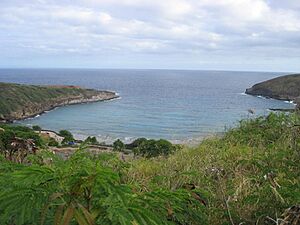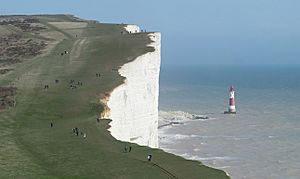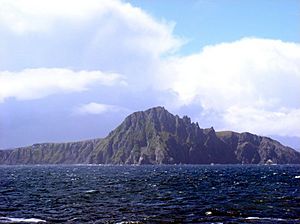Headlands and bays facts for kids
Have you ever seen a coastline that isn't straight? Sometimes the land curves inward, creating a calm, sheltered area. This is called a bay. Other times, the land sticks out into the sea, bravely facing the waves. This is a headland. Headlands and bays are common along coastlines. They are shaped over thousands of years by the powerful ocean waves. Different types of rock along the shore also play a big part. Learning about them helps us understand how our planet's surface is always changing.
Contents
What Are Headlands and Bays?
Headlands and bays are two types of landforms you often see together on a coastline. They are like opposites that go hand-in-hand.
- A headland is a high piece of land. It sticks out into the sea. Headlands are usually made of strong, hard rock. They face the full force of ocean waves.
- A bay is a wide, curved area of the coastline. It is often found between two headlands. Bays are usually protected from strong waves. They often have sandy beaches.
How Do Headlands and Bays Form?
Headlands and bays form because different types of rock react differently to the ocean's power. This process takes a very, very long time.
Why Do Rocks Erode Differently?
The main reason headlands and bays form is called differential erosion. This means that different types of rock wear away at different speeds.
- Hard rock is very strong. It resists the power of waves. This rock erodes slowly. The hard rock forms the headlands that stick out.
- Soft rock is not as strong. It erodes much faster. This softer rock is worn away quickly. This creates the curved bays.
Imagine a coastline with layers of hard and soft rock. The waves will hit both. The soft rock will be removed faster, making a curve inward. The hard rock will stay, forming the land that juts out.
How Do Waves Shape the Coast?
Waves are very important in shaping these features. They carry energy that wears away the land.
- Waves hit headlands with great force. This is because headlands are exposed. They take the full impact of the waves. This constant pounding helps to shape the headland.
- In bays, waves are often less powerful. The bay's curved shape helps to spread out the wave energy. This means less erosion happens inside the bay.
What Is Weathering's Role?
Besides waves, other natural processes also help shape headlands and bays. These are called weathering. Weathering breaks down rocks.
- Physical weathering includes things like freeze-thaw. Water gets into cracks in the rock. When it freezes, it expands. This makes the cracks bigger. It can break off pieces of rock.
- Chemical weathering happens when rainwater reacts with minerals in the rock. This can slowly dissolve or change the rock. This makes it weaker.
- These weathering processes weaken the rock. This makes it easier for waves to erode the coastline.
What Features Do Headlands Have?
Headlands often have amazing landscapes. They show clear signs of strong wave action.
Sea Caves and Arches
As waves hit headlands, they can find weak spots in the rock.
- Sea caves form when waves erode a weak spot at the bottom of a cliff. This creates a hollow space.
- If a cave forms on both sides of a headland, and waves erode through, a sea arch can form. This is a natural bridge made of rock.
Sea Stacks and Stumps
Over time, sea arches can collapse.
- When the top of a sea arch falls, a tall pillar of rock is left standing alone in the sea. This is called a sea stack.
- Waves can erode a sea stack even more. Eventually, it becomes a small, low rock feature. You might only see it at low tide. This is known as a sea stump.
What Features Do Bays Have?

Bays are often calmer and more inviting than rugged headlands.
Sandy Beaches
Many bays are home to beautiful sandy beaches.
- Bays are sheltered, which allows sand and other small pieces of rock to settle. Waves lose energy as they enter the bay.
- When waves lose energy, they drop the sand and pebbles they carry. This material builds up to form a beach.
Sheltered Waters
The curved shape of a bay offers natural protection.
- The headlands around the bay block strong winds and large waves. This makes the water inside the bay much calmer.
- Calm waters are safer for boats. They also offer good conditions for swimming and other water activities.
Why Are Headlands and Bays Important?
Headlands and bays are more than just interesting landforms. They are important for nature and for people.
Natural Harbors
The calm waters of bays have been very important throughout history.
- Many major ports and cities are built around natural bays. The calm waters provide safe places for ships to anchor.
- This protection helps with loading and unloading goods. It also keeps ships safe from storms.
Wildlife Homes
Both headlands and bays provide homes for many different plants and animals.
- Headland cliffs are often nesting sites for seabirds. The exposed rocks are also home to special plant species.
- Bays, with their calmer waters, support many types of sea life. Fish, crabs, and other creatures live well in these sheltered areas.
Tourism and Fun
These coastal features are popular places for people to visit.
- Beaches in bays attract tourists for swimming, sunbathing, and watersports.
- Headlands offer amazing views. They are popular for hiking and sightseeing. Their dramatic scenery brings many visitors.





